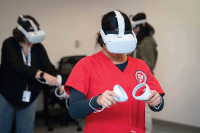Mitigating obesity, depression, and dementia risk with blue zone habits
Chronic diseases, including obesity, depression and dementia, pose significant risks to health, and they’re on the rise. Understanding connections among these conditions along with socioeconomic barriers can enhance nurses’ approach to patient care. In their role, nurses are uniquely positioned to help individuals and communities manage risks and prevent chronic disease through lifestyle changes and strategies such as those known as Blue Zone habits.
Barriers to optimal health
Obesity and depression share a bidirectional link in that one increases the risk for the other, and both independently increase the risk of dementia. Obesity in people between the ages of 40 and 60 causes systemic inflammation, which affects the brain via the gut-brain axis. This, in turn, elevates a person’s risk of depression in middle age and dementia in older age. Multiple meta-analyses link depression with metabolic changes that increase the risk for obesity and diabetes. According to the World Health Organization, rates of obesity and depression continue to increase, and depression ranks as the most common cause of impairment worldwide.
Obesity is a complex condition influenced by multiple factors, including genetics, gender, socioeconomic status, dietary habits, and depression. Socioeconomic barriers frequently make it difficult for individuals to access nutritious foods, as healthier options are more expensive. These barriers also limit access to the time and resources needed for exercising, preparing healthy food, and engaging in social activities. People living paycheck to paycheck are less likely to live in communities with parks and recreational activities, and the high cost of living can make gym memberships, healthy food, and weight loss medications unaffordable.
Nursing’s role in lifestyle medicine
Obesity and depression frequently coexist, and together they raise the risk for dementia. Separately, depression can be a precursor to dementia, which in turn has been described as a third type of diabetes caused by a chronically impaired insulin response associated with type 2 diabetes. Research by Selman and colleague found that about 40% of the U.S. population is obese, over 54 million people are diagnosed with dementia globally, and that dementia rates are expected to rise by 60% in the next 3 decades. As nurses, we can change this bleak future by educating our patients and communities about lifestyle modifications that reduce the risk of all three disorders.
Lifestyle interventions
Healthy lifestyle changes serve as powerful weapons in the fight to prevent chronic disease. An effective strategy for weight loss combines a healthy diet with exercise. An ideal diet is mostly plant-based, low in saturated fat, and contains limited amounts of processed foods and red meat. As little as 1 hour of exercise each week can reduce depression. Walking just under 10,000 steps per day can reduce dementia risk by half, and speed-walking for 30 minutes per day reduces risk even further by up to 60%. In addition to diet and exercise, giving up tobacco and excessive alcohol consumption in middle age also helps to reduce dementia risk. Nurses can inspire their patients to make these changes by sharing real-life success stories.
Blue Zone habits
In the book Blue Zones, Dan Buettner explored places around the globe where people regularly live long, healthy lives free of disease and disability. He dubbed these places “blue zones.” These communities include Okinawa, Japan, Sardinia, Italy, Nicoya, Costa Rica, Ikaria, Greece, and Loma Linda, California. He studied the lifestyle habits typical of people who live in blue zones and found that they all practiced some version of nine healthy habits. The first habit involves daily exercise. The second entails cultivating a sense of purpose, which adds an estimated 7 years to the average life. The third healthy habit involves a daily ritual to decrease stress, such as a prayer, a nap, or a cocktail with friends. The fourth relates to maintaining a healthy weight by eating progressively smaller meals throughout the day and ending meals before feeling full.
The fifth blue zone habit is eating a minimally processed diet high in various plant foods with small amounts of meat. The sixth involves moderate but regular consumption of wine or grapes. The seventh concerns joining a community of faith, which can add 14 years to the average life. The eighth habit entails maintaining close connections with family across several generations, and the ninth involves fostering social connections and close friendships with like-minded individuals who practice healthy lifestyles.
Challenges and solutions
Nurses play a pivotal role in educating patients and caregivers about these blue zone habits and in acting as role models by adopting them. However, we must do more to address the socioeconomic barriers that hinder patients from achieving healthier lifestyles.
Many communities aren’t designed to make choosing healthy habits easy, but programs like the Blue Zones Project are changing this. This initiative works with local governments to build walkways, create bike trails, and clean up local parks. By partnering with local markets, eateries, schools, and businesses, the Blue Zones Project and other similar initiatives make healthy food more accessible and affordable. They also work with community groups to encourage social connections through volunteer work, hobbies, and group exercise. The city of Albert Lea, MN, saw claims related to healthcare visits cut in half in less than a year. Additionally, three beach cities in California significantly reduced rates of obesity and smoking over 5 years, saving about $12 million in healthcare costs. Nurses can improve the health of individuals and communities and reduce healthcare costs by providing education about blue zone habits, acting as role models, and advocating to ensure better access to health-promoting resources.
—Laura L. Woodward is a board-certified psychiatric mental health nurse practitioner and an instructor in the School of Nursing at the University of Alabama at Birmingham. Stacy E. Stuart is a board-certified psychiatric mental health nurse practitioner in private practice in Alabama. Loretta T. Lee, an Alabama State Nurses Association member, is a board-certified family nurse practitioner and a professor in the School of Nursing at the University of Alabama at Birmingham.
For healthy resources from ANA, visit HNHN.org.
References
Buettner D. 9 lessons from the world’s Blue Zones on living a long, healthy life. World Economic Forum. Published June 26, 2017. August 26, 2024. https://www.weforum.org/agenda/2017/06/changing-the-way-america-eats-moves-and-connects-one-town-at-a-time
Franz MJ, VanWormer JJ, Crain AL, et al. Weight-loss outcomes: A systematic review and meta-analysis of weight-loss clinical trials with a minimum 1-year follow-up. Journal of the American Dietetic Association, 2007; 107: 1755-1767. doi: https://doi.org/10.1016/j.jada.2007.07.017
Harvey SB, Øverland S, Hatch SL, Wessely S, Mykletun A, Hotopf M. Exercise and the prevention of depression: Results of the HUNT Cohort Study. American Journal of Psychiatry, 2018; 175: 28-36. doi: https://doi.org/10.1176/appi.ajp.2017.16111223
Li XY, Zhang M, Xu W, et al. Midlife modifiable risk factors for dementia: A systematic review and meta-analysis of 34 prospective cohort studies. Current Alzheimer Research, 2020; 16: 1254-1268. doi: https://doi.org/10.2174/1567205017666200103111253
Ly M, Yu GZ, Mian A, et al. Neuroinflammation: A modifiable pathway linking obesity, Alzheimer’s disease, and depression. The American Journal of Geriatric Psychiatry, 2023; 10: 853-856. doi: https://doi.org/10.1016/j.jagp.2023.06.001
Milaneschi Y, Simmons WK, van Rossum EFC, Penninx BW. Depression and obesity: evidence of shared biological mechanisms. Molecular Psychiatry. 2018; 24 :18-33. doi: https://doi.org/10.1038/s41380-018-0017-5
Selman A, Burns S, Reddy AP, Culberson J, Reddy PH. The role of obesity and diabetes in dementia. International Journal of Molecular Sciences, 2022; 23 :9267. doi: https://doi.org/10.3390/ijms23169267
Walk This Many Steps a Day to Halve Your Dementia Risk. Fisher Center for Alzheimer’s Research Foundation. Published 2024. Accessed August 26, 2024. https://www.alzinfo.org/articles/prevention/walk-this-many-steps-a-day-to-halve-your-dementia-risk/




















